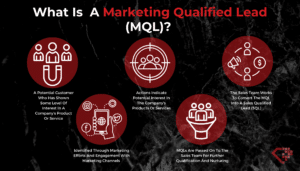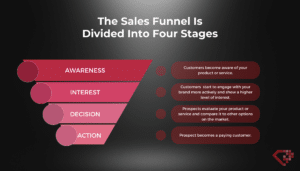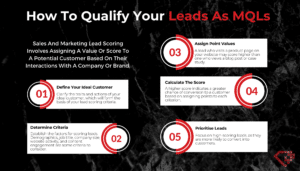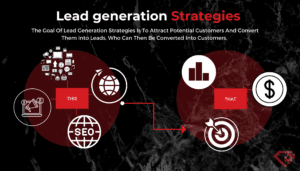In this guide, we will provide you with a comprehensive understanding of the difference between leads and Marketing Qualified Leads (MQLs). If you are a business owner or marketer, it’s crucial to know the distinction between these two terms and how they can impact your sales funnel. Throughout this post, we will discuss the definitions of leads, MQLs and SQLs, how they fit into your sales funnel, how to qualify leads as MQLs, and effective lead generation strategies. Knowing the difference between leads and MQLs is essential because it helps you prioritise your sales efforts and focus on the most promising prospects. Leads are individuals who have expressed some level of interest in your product or service, while MQLs are prospects who have shown a higher level of engagement and are more likely to convert into paying customers. So, let’s explore leads and MQLs and discover how they can help you achieve your business goals!
What is a Lead?
Before we dive in, let’s define exactly what we mean when we talk about a lead. A lead is an individual who has shown interest in your business or product, but has not yet become a customer. In other words, a lead is a potential customer who is still in the early stages of the buying journey. Leads can be generated through a variety of channels, including marketing efforts and direct interactions with your business. Marketing efforts may include advertising, content marketing, or social media outreach to attract potential customers to your website or landing pages. Direct interactions with your business may include website enquiries, offline contact, or phone calls. Leads are typically located at the top of the sales funnel. At this stage, they have shown some level of interest in your product or service, but have not yet committed to making a purchase. As such, the goal of the sales team at this stage is to nurture the lead and move them further down the funnel towards making a purchase.
What is a Marketing Qualified Lead (MQL)?
A Marketing Qualified Lead (MQL) is a lead that has been identified as having a higher level of interest and engagement with your business than a regular lead. MQLs are prospects who have been qualified as a reasonable lead to follow up with and nurture down the sales funnel. Think of them as warm leads, who have shown a greater likelihood of converting into paying customers. MQLs are typically qualified by the marketing team based on certain criteria, such as demographic information, firmographic data, or behaviour. For instance, if you run a marketing SaaS company, your target market may be marketing directors or decision-makers in a business. An MQL for your business may be someone who fits specific criteria like having the job title of a marketing director or having demonstrated a high level of engagement with your content or product. The goal of identifying MQLs is to enable the sales team to focus their efforts on prospects who are more likely to convert. By ensuring that leads are qualified and match the desired target market, businesses can save time and resources by directing their sales efforts towards the most viable prospects. In summary, MQLs are leads that have been qualified as fitting into the desired target market of any marketing activity being run. They are identified by the marketing team and can then be passed on to the sales team for further nurturing and conversion.

How Leads and MQLs Fit into a Sales Funnel
The sales funnel is a framework used to visualise the customer journey, from initial awareness of a product or service to the final purchase. It’s called a “funnel” because it represents the way in which customers move through different stages of the buying journey, with a decreasing number of prospects at each stage. The sales funnel is typically divided into four stages: Awareness, Interest, Decision, and Action. At the top of the funnel is the Awareness stage, where customers become aware of your product or service. This is where leads are typically located. As leads move down the funnel, they enter the Interest stage, where they start to engage with your brand more actively and show a higher level of interest. This is where MQLs fit into the funnel, as they have been identified as having a higher level of interest and engagement with your business than regular leads. Next comes the Decision stage, where prospects evaluate your product or service and compare it to other options on the market. Finally, at the bottom of the funnel is the Action stage, where the prospect becomes a paying customer. It’s important to note that not all leads will make it down the funnel to become customers. However, by focusing on qualified leads like MQLs, businesses can increase their chances of success by nurturing these leads with targeted marketing and sales efforts. If you want to learn more about the next step after MQLs, check out our blog post on the difference between MQLs and SQLs (Sales Qualified Leads). 
How to qualify your leads as MQLs
Qualifying leads as MQLs requires a systematic approach to determine which leads are most likely to convert into paying customers. Here are some strategies to help you qualify your leads as MQLs:
- Refine contact forms or points of contact to get the most valuable information from leads to be able to qualify them quickly. Contact forms or landing pages should ask for information that is relevant to your target market and can help you identify high-value prospects.
- Implement a lead scoring process to assign scores to leads based on their interactions with your business. Lead scoring is a method of ranking leads based on their readiness to buy, allowing you to focus on the most qualified leads. Factors to look at for lead scoring include demographics, company information, and website interactions.
- Problem resolution – determine whether your product or service actually addresses the problem the lead is trying to solve. This will help you identify the most viable prospects and target your marketing efforts accordingly.
- Use qualifying questions to help assess the lead’s readiness to buy. These questions can help you understand the lead’s needs, pain points, and budget, allowing you to determine whether they are a good fit for your business. Here are a few examples:
- What is your biggest current challenge or pain point?
- What specific results are you hoping to achieve?
- What is your budget for this solution?
- What is your timeline for making a decision?
- Who will be involved in the decision-making process?
- Have you used a similar product or service in the past? (If the answer to this question is yes, you may want to follow up with what they didn’t like about their previous solution and why they are looking for an alternative)
- How important is [specific feature or benefit] to you?
- What other solutions are you considering?
- Do you have any concerns or objections about our product/service?
These questions can help businesses understand the lead’s needs and decision-making process, allowing them to determine whether the lead is a good fit for their business and how to best approach the sales conversation. By refining your contact forms, implementing lead scoring, determining the lead’s needs, and using qualifying questions, you can qualify your leads as MQLs and focus your sales efforts on the most sales-ready leads.

Lead generation Strategies
Generating leads is a critical aspect of any business, and there are several marketing strategies that can be deployed to generate leads. Here are some common lead generation strategies: SEO: Search Engine Optimisation is a strategy that helps businesses rank higher in search engine results pages, which can drive organic traffic to your website. This strategy involves optimising your website for specific keywords and ensuring that your website’s content is high-quality and relevant to your target audience. Google Ads: Google Ads is a pay-per-click advertising platform that allows businesses to display their ads on search engine results pages (SERPs) or other websites. This strategy can be highly effective in driving targeted traffic to your website. Social media: Social media platforms such as Facebook, LinkedIn, and Twitter can be used to reach potential customers and generate leads. These platforms can be used to promote your brand, engage with your audience, and drive traffic to your website. Content marketing: This strategy involves creating and distributing high-quality content such as blog posts, infographics, and videos to attract potential customers and build brand awareness. Email marketing: Email marketing involves sending targeted messages to leads and customers to nurture relationships and promote your products or services. It’s important to note that the marketing strategies you use to generate leads may differ depending on your marketing intentions and where your potential customers might find you. For instance, if you want people to find out about your business, you might focus on push marketing strategies such as advertising and promotions. On the other hand, if your target audience is already searching for a solution, you might focus on pull marketing strategies such as SEO and content marketing.

Check out our blog post for more information on push versus pull marketing strategies.
In conclusion
Generating high-quality leads is essential for businesses to succeed in today’s competitive landscape. In this guide, we’ve covered the basics of leads and Marketing Qualified Leads (MQLs), how they fit into the sales funnel, how to qualify leads as MQLs, and effective lead generation strategies. At Ruby Digital, we understand the importance of generating high-quality leads and can help businesses implement effective lead generation strategies to achieve their goals. Whether you need help refining your contact forms, implementing lead scoring, or driving traffic to your website, our team of experts is ready to assist you. If you have any questions or need assistance with your digital marketing efforts, please get in touch. Let’s work together to take your business to the next level!



